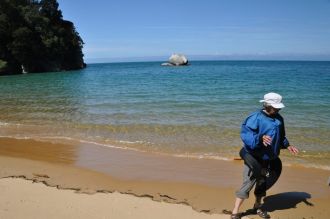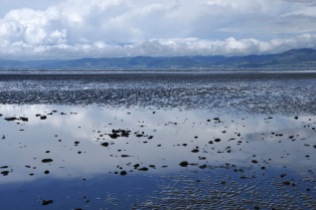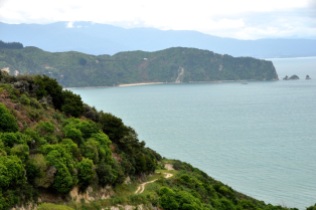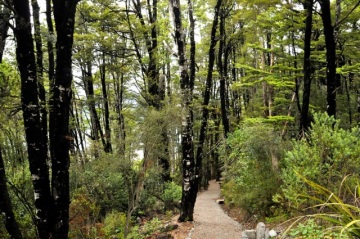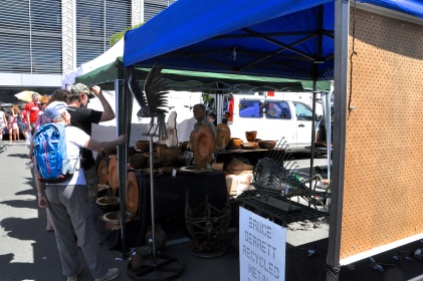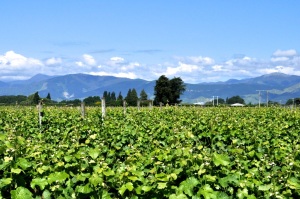 I’ve shown you Nelson Lakes National Park before (post of Dec 29 2013, “Nelson Lakes National Park“). It’s a pretty area, nestled at the northernmost limit of the Southern Alps and serviced by the sleepy village of St. Arnaud, population 100. This time we are revisiting with company – similar to our last post on Abel Tasman National Park. First to visit is our son Brian and his girlfriend Janaki. When last we were here, Ginger climbed the challenging Mt. Robert (that mountain on the right), a 2,000 foot ascent up the Pinchgut Track, correctly labeled “steep”. Due to the lateness of the day and impending clouds, on that climb we had backtracked down the Pinchgut rather than complete the slightly longer 6 mile loop. This time we plan to do the reverse climb, doing the 6 mile loop and only going down the Pinchgut. Alas, when we get there, that trail head has signs saying it is temporarily closed. Rats! So off we go, once again up the Pinchgut.
I’ve shown you Nelson Lakes National Park before (post of Dec 29 2013, “Nelson Lakes National Park“). It’s a pretty area, nestled at the northernmost limit of the Southern Alps and serviced by the sleepy village of St. Arnaud, population 100. This time we are revisiting with company – similar to our last post on Abel Tasman National Park. First to visit is our son Brian and his girlfriend Janaki. When last we were here, Ginger climbed the challenging Mt. Robert (that mountain on the right), a 2,000 foot ascent up the Pinchgut Track, correctly labeled “steep”. Due to the lateness of the day and impending clouds, on that climb we had backtracked down the Pinchgut rather than complete the slightly longer 6 mile loop. This time we plan to do the reverse climb, doing the 6 mile loop and only going down the Pinchgut. Alas, when we get there, that trail head has signs saying it is temporarily closed. Rats! So off we go, once again up the Pinchgut.
What makes the trip more interesting for us is that Janaki, bless her heart, has never hiked up a mountain, much less one that’s a hard 2ooo feet up. The path starts gently, but rapidly turns into a series of steep switchbacks. Early on, Ginger realizes that this is not her day to hike and decides it would be wise to turn back, particularly since she’s done this hike before. The rest of us continue on, but as we look out from the trail, we discover that the high clouds (visible in the first picture) are not quite so high anymore; they’re lower, and they’re coming our way. Nooooooooooo!
We keep climbing, and the clouds keep lowering. As you may remember, the trail goes in and out of the woods, but when it comes out, the view below is increasingly and disappointingly obscured. Janaki, however, is doing great and is plowing uphill just fine,
in spite of the impressive incline. The view is crap, but the kids are enjoying being inside a cloud. OK, but what about the view you’re missing?
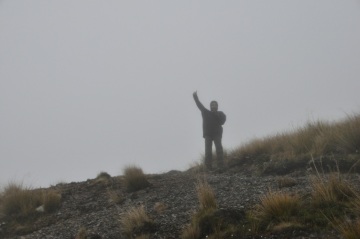 Finally we clear the woods for the last time and shortly we’re at the plateau top. Yeah, the loop continues up a little further, but what’s the point? The view won’t change! So back down the Pinchgut we go, still stuck inside that darn cloud! I’m grumbling in my beard, but the kids still think being in a cloud is cool.
Finally we clear the woods for the last time and shortly we’re at the plateau top. Yeah, the loop continues up a little further, but what’s the point? The view won’t change! So back down the Pinchgut we go, still stuck inside that darn cloud! I’m grumbling in my beard, but the kids still think being in a cloud is cool.
Just two final photos: the view back at the trailhead, with victorious climbers Brian and Janaki; and the view of the lake and the mountain from St. Arnaud, showing Mt. Robert being sat on by a cloud – which, on the right side of the mountain, funnels right down the Pinchgut track!
Those clouds are just mean!
………………………………………………………………………………………………………………………………………………………………………………………………….
 Next to visit Nelson Lakes is John Chang, our California friend. This time we’ll climb the mountains on the other side of Lake Rotoiti, the St. Arnaud range; it’s a tougher climb, a longer and higher up-and-back. A disadvantage of this climb is that, unlike Mt. Robert where the trail goes in and out of the woods, offering panoramic views as you go (if you’re not inside a cloud), this climb is all woods most of the way until you finally emerge onto treeless tundra. At the start the trail is pretty smooth and gentle, and the birch forest is beautiful. Soon, however, the trail heads up – rather steeply – and becomes rough, peppered with rocks and roots.
Next to visit Nelson Lakes is John Chang, our California friend. This time we’ll climb the mountains on the other side of Lake Rotoiti, the St. Arnaud range; it’s a tougher climb, a longer and higher up-and-back. A disadvantage of this climb is that, unlike Mt. Robert where the trail goes in and out of the woods, offering panoramic views as you go (if you’re not inside a cloud), this climb is all woods most of the way until you finally emerge onto treeless tundra. At the start the trail is pretty smooth and gentle, and the birch forest is beautiful. Soon, however, the trail heads up – rather steeply – and becomes rough, peppered with rocks and roots.
 We finally clear the forest – we’ve been working hard! – and not far away is a rocky outcrop with a view. This is the turn-around point for many climbers, and we decide to stop here for our well-earned lunch as we catch our breath and cool our heels. It’s a pretty view, Mt Robert and Lake Rotoiti in front of us, and the valley heading north off to our right, as shown below.
We finally clear the forest – we’ve been working hard! – and not far away is a rocky outcrop with a view. This is the turn-around point for many climbers, and we decide to stop here for our well-earned lunch as we catch our breath and cool our heels. It’s a pretty view, Mt Robert and Lake Rotoiti in front of us, and the valley heading north off to our right, as shown below.
 We, of course, will not be deterred from reaching the top. No wimps, we! You will note, however, from the picture to the side, that the terrain is wickedly steep. We’ll actually be climbing up the mountain to the left of this picture, but it’s no less steep! The picture below shows some pretty flora on the mountainside
We, of course, will not be deterred from reaching the top. No wimps, we! You will note, however, from the picture to the side, that the terrain is wickedly steep. We’ll actually be climbing up the mountain to the left of this picture, but it’s no less steep! The picture below shows some pretty flora on the mountainside  as we hike up – I’m taking pictures of flowers, not catching my breath, honest!
as we hike up – I’m taking pictures of flowers, not catching my breath, honest!
Going up the steep incline, we occasionally stop and turn around to catch the increasingly awesome view of our stoney outcrop, Mt Robert, Lake Rotoiti, St. Arnaud, and the mountains in the distance.
Near the top it gets really steep (it wasn’t before?) and we have to use our hands as well as our feet to go up; we’re crawling! And then we’re there.
It’s bloomin’ Awesome! Unlike Mt. Robert, this ridge top is sharp, so there is a nearly 360º view – including the other side of the mountain that we have never seen. To start off, let me show you the view you’ve been seeing, that of Mt. Robert. Note in the foreground that it looks like you’ll fall off a cliff if you take a step forward. Yep, the climb up was steep! The trail continues at a right angle along the ridge, but that must be for hikers spending the night somewhere. We’re
happy not to be going further! Pictures can’t capture the whole gorgeous scene, but I’ll show you a few.
 Some of the plants up here are pretty interesting – for example, this thing growing on the rocks.
Some of the plants up here are pretty interesting – for example, this thing growing on the rocks.
Time to go back down, and Surprise! Going down that steep part turns out to be more of a challenge than going up! The pictures below don’t do the steepness any justice – pointing the camera downhill flattens the terrain. We find that walking this section is impossible, sliding is not a great option, and the only thing that works is to sidestep/slide/fall without a lot of control, heading toward a big rock or clump of grass (hopefully anchored) to stomp on to arrest the downward momentum. It’s more tricky than it sounds, and – ah – not always successful!
One last view of Mt Robert and Lake Rotoiti from above, and the tough trail going down.
We are, in fact, getting very tired navigating the hard trail, which is more step down and jump than walk a path. Our legs are getting shaky and threatening to cramp, but  we finally make it back, tired but happy. Our hike took us up the middle fold of that St Arnaud range – reasonably impressive, yeah?
we finally make it back, tired but happy. Our hike took us up the middle fold of that St Arnaud range – reasonably impressive, yeah?
A final look at lake Rotoiti – and one of its inhabitants, an eel.
Next post – leaving the South Island.




































